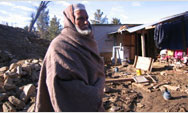You are here » Home » Telling Our Story
Success Story
Cost-effective farming technique improves yields and helps the environment
Eco-Friendly Farming Takes Root

| |
Photo: USAID/South Asia Rice-Wheat Consortium
|
|
This farmer uses zero tillage to plant wheat and rice — cutting his
costs and increasing his yields.
"My total yield every season has increased by at least 20 percent, and it saves me so
much money," says Arun. "All my neighboring farmers have seen this and also have begun to use it."
|
Across India's vast breadbasket, millions of farmers anxiously count the days between their wheat
harvest and rice planting season. Too many lost days could cost them a month's salary, so many farmers
desperate for a fast crop turnaround believe that burning plant residue is a better use of their time
than plowing the land. It's terrible for the environment and the land, but in farmers' minds, it saves money.
Now, with the help of USAID, a new agricultural technique is sweeping across India's northern rice
— and wheat-growing belt, helping farmers save time — and conserve precious natural resources.
Called "zero-till," the method eliminates the need for farmers to engage in expensive and time-consuming
tilling and plowing, or in harmful burnoffs. When planting, they now use a seeder strong enough to cut
through crop residue and drop seeds directly into the soil. This practice reduces tractor fuel use by 75
percent and water use by up to 50 percent, while simultaneously obtaining better yields. Farmers save at least $65 per hectare in production costs - a huge boost for their profit margins.
In Uttaranchal in northern India, farmer Arun Bhaku has used the zero-till method for two years for
his rice and wheat. "My total yield every season has increased by at least 20 percent, and it saves me
so much money," he says. "All my neighboring farmers have seen this and also have begun to use it."
Dr. Raj Gupta, director of the New Delhi-based Rice and Wheat Consortium, says that the environmental
benefit of zero-till is as high as the cost savings. "Leaving a protective blanket of leaves, stems and
stalks from the pervious crop on the surface is actually better for the long-term health of the crops
and soil." Residues provide a natural herbicide, retain nutrients in soil and moderate soil temperature.
"By burning the residue, farmers were actually stripping the soil of microbes and moisture that are
essential to a crop's long terms health," he added.
In 2004, a million hectares of farmland — a tenth of the total land farmed for rice and wheat
on India's plains — was planted using the zero-till approach, affecting 10,000 farmers.
USAID continues to support the development of improved or expanded techniques; the seeder has now
been modified to be used for chickpea, maize and sorghum crops as well.
Print-friendly version of this page (40kb - PDF)
Click here for high-res photo
Back to Top ^ | 

